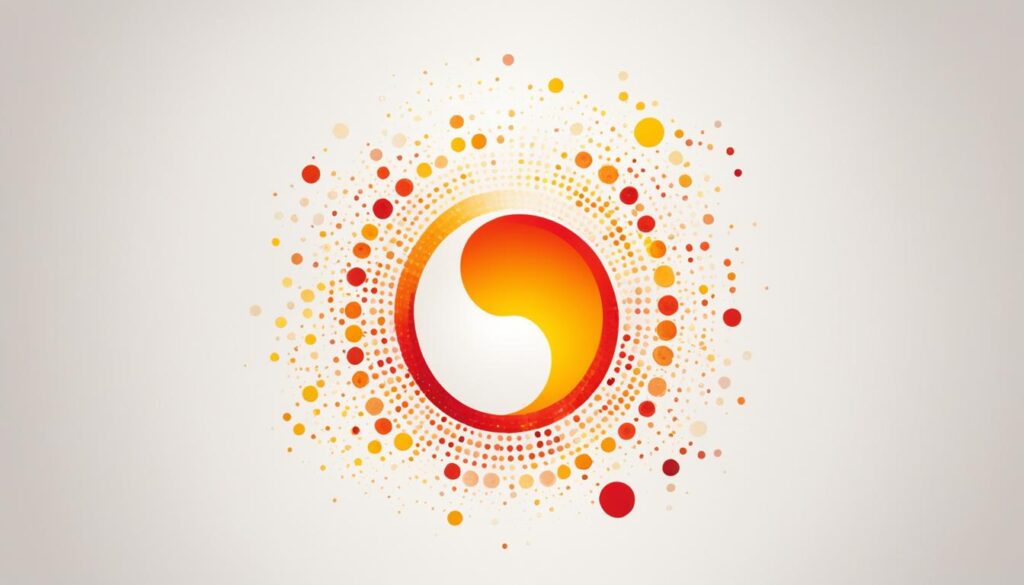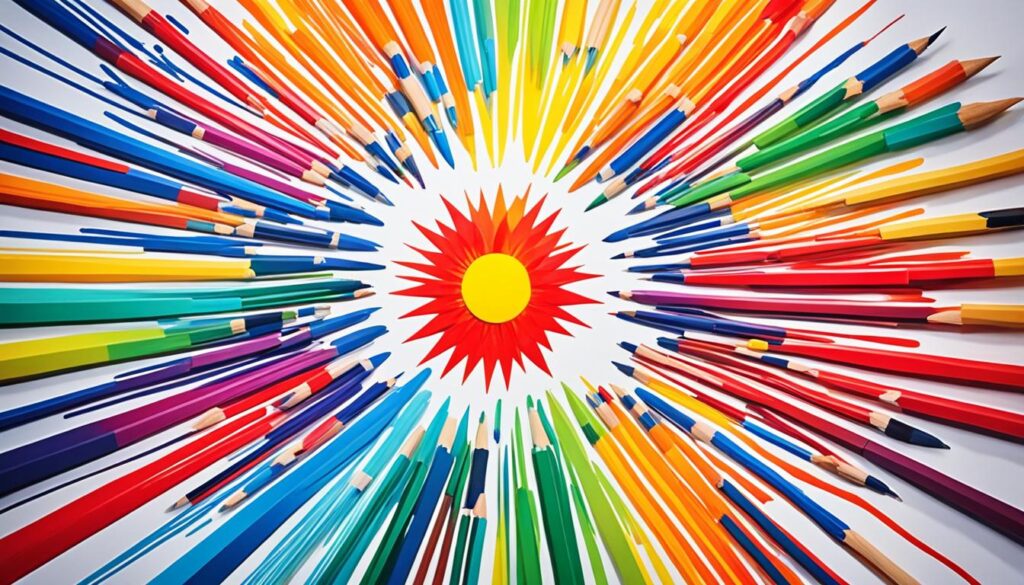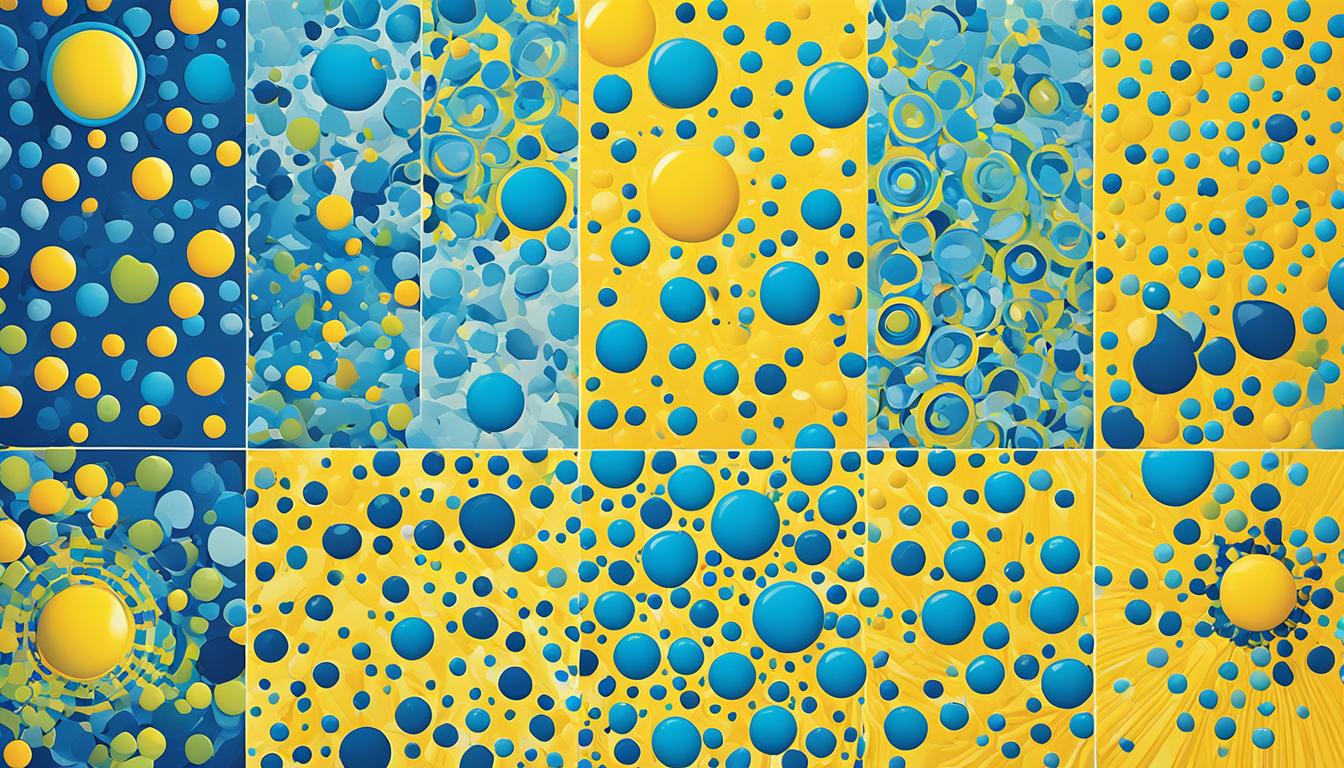Have you ever wondered why certain colors make you feel a certain way? Why does seeing the color red evoke intense emotions, while blue brings about a sense of calm? The psychology of color delves into the fascinating world of how different hues affect our mood and behavior. It goes beyond the surface-level aesthetics and uncovers the hidden power of color in shaping our emotional and cognitive responses.
From the moment we open our eyes, colors surround us and have a profound impact on our psychological well-being. Each shade carries its own symbolism and elicits specific emotional responses in individuals. But how does color perception psychology work? How do different colors influence our cognitive processes? And can we use this knowledge to create the desired outcomes in our lives?
In this article, we will explore the captivating realm of color psychology and uncover the secrets behind the effect of color on our mood and behavior. Join us as we embark on a journey to understand the emotional responses to color, the impact of color on our cognitive functions, and how we can apply this knowledge in various aspects of our lives.
Key Takeaways:
- Color psychology focuses on how different colors elicit specific emotional responses and influence our cognitive processes.
- Different colors have unique emotional effects on individuals, with cultural and personal associations shaping our interpretations.
- Colors can influence our mood and behavior, with warm colors stimulating energetic feelings and cool colors having a calming effect.
- Color also has significant cognitive effects, impacting our perception, attention, and memory.
- Understanding color psychology can empower us to create environments and experiences that align with our desired emotional states and behaviors.
The Emotional Effects of Different Colors
Different colors have a profound impact on our emotions, eliciting unique and powerful reactions within us. The emotional effects of color are diverse and can vary from person to person, but certain associations and symbolism are commonly shared.
Blue, for example, is often associated with feelings of calmness, tranquility, and serenity. It has a soothing effect on the mind and can help alleviate stress and anxiety. Many people find comfort in the color blue, which is why it is often used in bedrooms and spaces dedicated to relaxation.
Red, on the other hand, is a color that evokes intense emotions such as passion, love, and even anger. It is associated with energy, excitement, and power. Red has been shown to increase heart rate and stimulate the senses, making it a popular choice for attention-grabbing marketing materials and designs.
Color symbolism also plays a significant role in the emotional effects of color. Different cultures and individuals may have varying associations with specific colors based on their traditions, experiences, and personal preferences. For example, in Western cultures, white is often associated with purity and innocence, while in some Asian cultures, it is associated with mourning and sadness. These cultural associations shape how we interpret and emotionally respond to colors.
Understanding the emotional effects of different colors allows us to harness their power and use them strategically in various settings. In home decor, we can create spaces that evoke specific emotions by carefully selecting colors for different rooms. In marketing, brands can use color to evoke emotional responses and build connections with their target audience. By understanding the emotional effects of color, we can enhance the impact of our designs, branding efforts, and overall experiences.
Key Takeaways
- Different colors have unique emotional effects on individuals.
- Blue is associated with calmness and tranquility, while red evokes passion and intensity.
- Color symbolism varies across cultures and personal associations.
- Understanding the emotional effects of color allows us to use them strategically in various settings.
Color’s Impact on Mood and Behavior
Colors have a profound influence on our mood and behavior, shaping our emotional responses and cognitive processes. Understanding color psychology is crucial for harnessing the power of different hues to create desired outcomes in various aspects of our lives. In this section, we will delve into how colors can affect our mood and behavior, their role in marketing, and the concept of mood-enhancing colors.

The Impact of Color on Mood
Warm colors such as red, yellow, and orange are known for their ability to increase arousal and stimulate energetic feelings. They can create a sense of excitement and enthusiasm. Red, in particular, is often associated with passion and intensity, while yellow is linked to happiness and optimism.
Cool colors, on the other hand, like blue and green, have a calming and soothing effect on our mood. They can evoke feelings of tranquility and relaxation. Blue is commonly associated with serenity and trust, while green represents nature, growth, and harmony.
By strategically incorporating these mood-enhancing colors into our environment, such as through interior design or the use of color schemes, we can create a positive atmosphere that aligns with our desired emotional state.
The Influence of Color on Behavior
Color’s impact on behavior is evident in the field of marketing and advertising. Companies utilize color psychology to elicit specific emotional responses from consumers and prompt desired behaviors. For example, red is often used to create a sense of urgency and drive impulse purchases. Additionally, blue is commonly employed to establish trust and reliability.
By understanding the power of color in marketing, businesses can strategically choose colors that resonate with their target audience and convey the desired message. Whether it’s the colors used in a brand’s logo or the hues utilized in a product packaging, color plays a crucial role in attracting attention, evoking emotions, and influencing consumer behavior.
Creating a Positive Environment
Integrating mood-enhancing colors into our daily life can help create a conducive environment that promotes positivity and well-being. Whether it’s through the choice of clothing color, home decor, or even the color scheme of a workspace, we can optimize our surroundings to support our desired mood and behavior.
“Color is a powerful tool that can shape our emotions and influence our decisions. By understanding the psychology behind it, we can intentionally harness its impact on mood and behavior.”
In conclusion, the psychology of color teaches us that different hues can significantly impact our mood and behavior. Understanding the emotional effects of colors and strategically incorporating them into our environment and marketing efforts allows us to create powerful experiences and positively influence those around us.
The Cognitive Effects of Color
Color perception psychology and color theory psychology reveal that color has a profound impact on our cognition. Research has shown that different hues can influence our perception, attention, and memory. Understanding the cognitive impact of color allows us to optimize our learning, productivity, and overall cognitive performance.
Certain colors have been found to enhance focus and concentration. For example, studies have shown that shades of blue can enhance cognitive performance and promote a sense of calmness and concentration. This makes blue an ideal color to incorporate in environments where focus and productivity are essential, such as offices, classrooms, and study spaces.
On the other hand, vibrant and warm colors like red and yellow have been associated with increased arousal and stimulation. These colors can be beneficial in situations that require creative thinking and problem-solving. For instance, incorporating touches of red or yellow in a creative studio or brainstorming room can help stimulate the mind and encourage innovative thinking.

Color theory, a branch of psychology, further explores the cognitive effects of different hues and their combinations. It investigates how color combinations can enhance visual perception, influence mood and behavior, and even affect memory recall. By understanding the principles of color theory, designers, marketers, and psychologists can strategically utilize color to evoke specific cognitive responses and convey intended messages.
Furthermore, color can also influence our cognitive associations and memory. Studies have shown that color can enhance memory recall and aid in information retention. For example, using color-coded systems in note-taking or creating visual cues with different colors can help improve memory recall and organization.
To fully understand the cognitive effects of color, it is essential to consider individual differences and cultural influences. Personal experiences, cultural backgrounds, and individual preferences can shape our perceptions and cognitive responses to different colors. Therefore, it is crucial to consider context and the target audience when utilizing color in various settings.
The Cognitive Effects of Color: Key Takeaways
- Color has a significant impact on our cognitive processes, including perception, attention, and memory.
- Different colors have distinct cognitive effects, with some enhancing focus and concentration, while others promoting creativity and stimulation.
- Color theory psychology explores the cognitive impact of color combinations and provides insights into how color can influence mood, behavior, and memory.
- Personal experiences and cultural influences play a role in our cognitive responses to color, highlighting the importance of considering context and target audience when utilizing color.
By understanding the cognitive effects of color, we can leverage its power to create environments, designs, and experiences that optimize cognitive performance and evoke desired cognitive responses.
Conclusion
The psychology of color uncovers the profound influence that colors have on our mood and behavior. Through understanding the emotional effects of different hues and their impact on our cognitive processes, we can leverage color psychology across various fields such as design, marketing, and personal development. By harnessing the psychological power of color, we have the ability to create environments and experiences that align with our desired emotional states and behaviors.
Colors elicit specific emotional responses, with warm hues like red, yellow, and orange stimulating energy and arousal, while cool colors such as blue and green promote calmness and tranquility. Additionally, color symbolism and cultural associations shape our emotional responses to different hues, opening up opportunities for strategic use in areas like home decor, branding, and advertising.
Furthermore, colors do not just impact our emotional state; they also have cognitive effects. Research has shown that certain colors can enhance focus, concentration, and memory, while others can stimulate creativity and specific cognitive functions. By understanding the cognitive impact of color, we can optimize our learning, productivity, and overall cognitive performance.
Overall, color psychology provides valuable insights into the ways in which colors can influence our well-being and experiences. Whether it’s designing a room, crafting a marketing campaign, or seeking personal development, the psychology of color offers a powerful tool for creating environments and experiences that align with our desired emotional states and behaviors. By applying the takeaways from color psychology, we can fully harness the potential of colors to enhance our lives and the lives of those around us.



